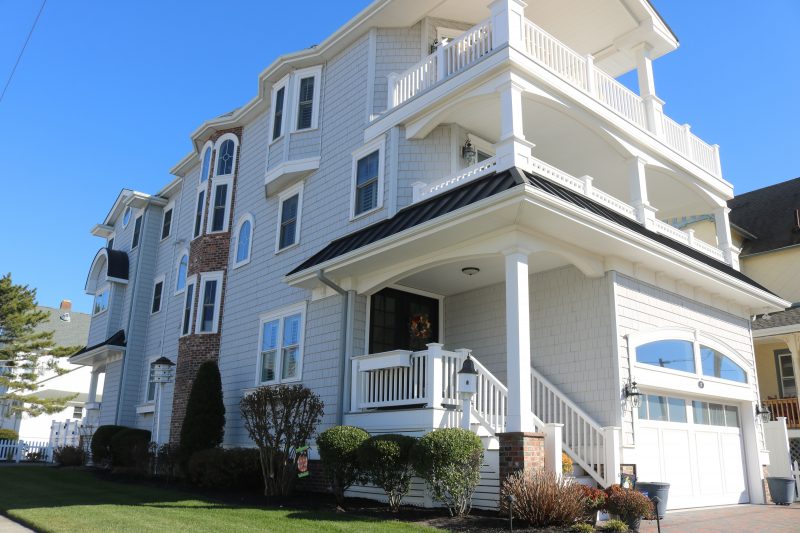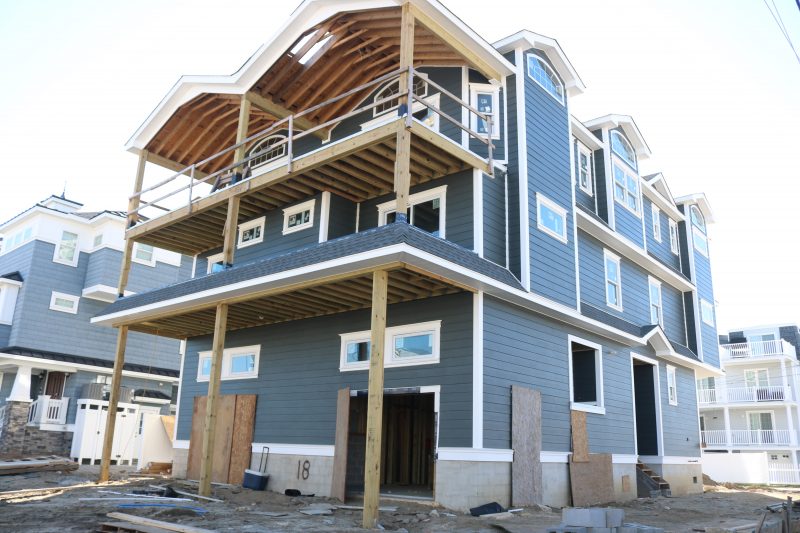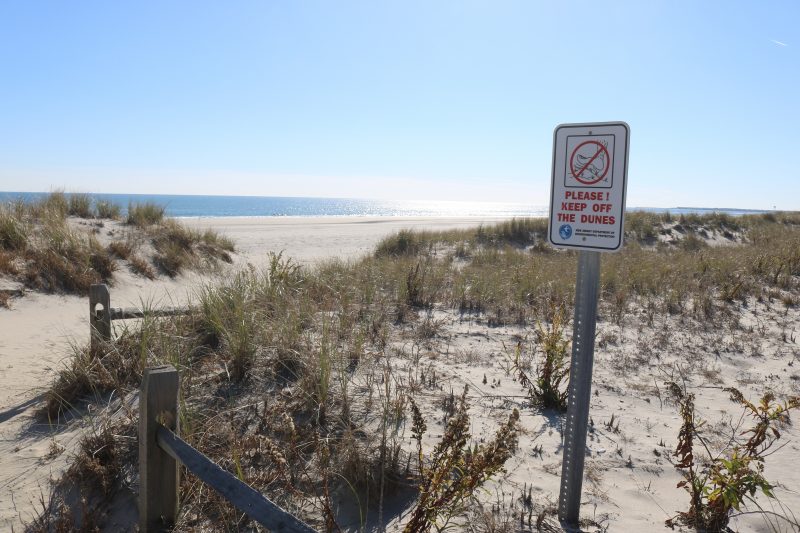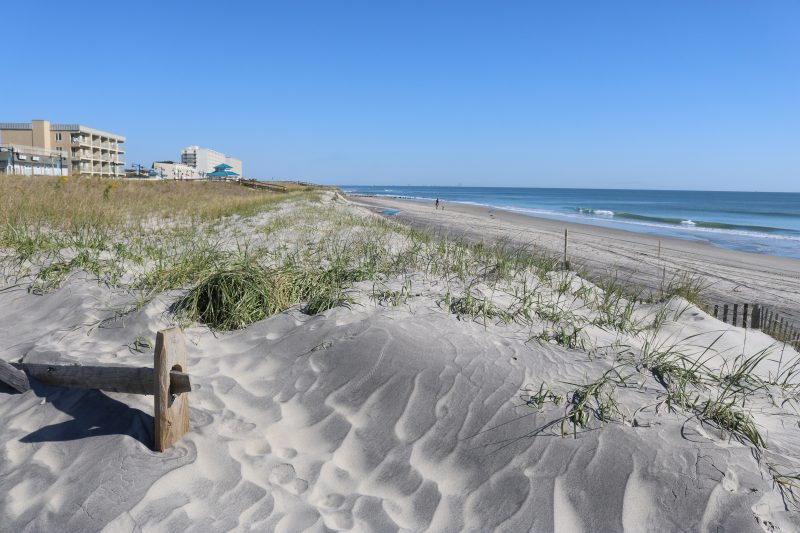The ordinance will provide more protection for the dunes.
 By DONALD WITTKOWSKI
By DONALD WITTKOWSKI
Sea Isle City is encouraging more homeowners to dress up the side of their houses with an architectural feature called “bump-outs” instead of having an expanse of long, blank exterior walls.
Bump-outs are decorative touches that include ornamental roofs or canopies placed above windows and doors to give the large, upscale homes that are becoming common in Sea Isle more curb appeal.
Voting 4-0 at a meeting Tuesday, City Council gave final approval to a new ordinance that will allow homeowners with smaller side yards to have bump-outs, but with certain limitations.
Currently, bump-outs are allowed when a homeowner has a side yard at least 6 feet wide, City Solicitor Paul Baldini said. But the bump-outs must be built a minimum of 5 feet from the property line to maintain enough space between homes.
Under the new ordinance, homeowners with side yards that are at least 5 feet wide will be able to have bump-outs. The bump-outs, though, will have to be smaller in size in those cases.
“This is a tweak of what we call our bump-out ordinance,” Baldini said. “The bump-out ordinance is designed to encourage developers and homeowners to create aesthetic designs along the side of the building with bump-outs to break up that long, wall look we were seeing years ago. We believe the ordinance has been extremely successful.”
In recent years, architectural features such as bump-outs have been a touchy subject in Sea Isle, a town that has been dealing with complaints on social media about large, high-end vacation homes gobbling up precious open space on the narrow island.
But Sea Isle officials believe that bump-outs are an attractive way to spruce up what would otherwise be the long, barren exterior walls on the side of the house. Now, the plan is to allow homeowners who have slightly smaller side yards to have bump-outs, too.
In earlier discussions about bump-outs, Councilman Jack Gibson has pointed out that the side walls are often the most visible part of the house, so they should be the ones that are enhanced with decorative architectural features.

A new house under construction at 45th Street and Pleasure Avenue is being spruced up with bump-outs on the side wall.
During Tuesday’s meeting, Council President Mary Tighe said she had received emails from people who were concerned that the new ordinance would allow bump-outs to “encroach” farther into the side yards.
Tighe stressed that the ordinance requires bump-outs to be smaller at homes with side yards that are 5 feet wide, so they will not encroach farther out into the property.
“We had had a certain measurement and we adjusted that measurement. That’s all it did. It does not affect the outside of the house as far as encroaching into the setback area,” she said of having smaller bump-outs.
The bump-outs will allow more homes to keep “that aesthetic look” instead of having a blank wall running along the side the house, Tighe noted.
In other business Tuesday, Council voted 4-0 to approve an ordinance that establishes a formal “dune line” along Sea Isle’s entire oceanfront.
The measure will ultimately provide more protection for the environmentally sensitive sand dunes, Baldini said.
“Our intention was not to reduce any protection out there,” he said in an interview after the Council meeting.
The dunes serve as a natural barrier against storms and are considered the first line of defense to protect homes, businesses and other parts of Sea Isle from the raging ocean.
“The city has an interest in ensuring that the beach, dunes, and dune area are protected,” the ordinance says.

The ordinance will provide more protection for the dunes.
Sea Isle is turning to the U.S. Army Corps of Engineers to designate a dune line along the entire length of the island from First Street to 94th Street.
Currently, Sea Isle does not have a formal dune line because it would be prohibitively expensive for the city to hire the engineers to do all the work that is needed, Baldini explained.
The dunes were changed when the Army Corps of Engineers replenished the city’s eroded beaches in recent years. Fortunately for Sea Isle, the Army Corps conducted extensive engineering work as part of the beach replenishment projects to establish the dune line.
The dune line will go as far west, toward land, as it can without touching anyone’s private property, Baldini said.
“The farthest western line is to protect the dunes the most,” he said.
The ordinance will also establish a new 6-foot buffer, or setback, for projects built near the dunes.
Currently, no buildings, carports, garages, parking spaces, decks, terraces, patios and other structures may be built closer than 10 feet of the dunes under Sea Isle’s zoning laws.
But the new ordinance reduces the setback to the dune line from 10 feet to 6 feet. Baldini said the dunes will still be protected by reducing the setback to 6 feet because of the far western track of the dune line.
At the same time, the new 6-foot threshold will reduce the number of applications to the city’s Zoning Board for variances to encroach into the setback area near the dunes, he noted.
Over the years, the dune line had become “pockmarked” because Sea Isle’s property owners had hired their own engineers to conduct surveys for construction projects that came close to the dunes, Baldini said.
Contractors and engineers who build projects for Sea Isle’s property owners will now be able to look at digital maps of the dune line established by the Army Corps of Engineers to avoid any confusion.

Dunes serve as a natural barrier to protect homes, businesses and other parts of Sea Isle from the raging ocean.
 By DONALD WITTKOWSKI
Sea Isle City is encouraging more homeowners to dress up the side of their houses with an architectural feature called “bump-outs” instead of having an expanse of long, blank exterior walls.
Bump-outs are decorative touches that include ornamental roofs or canopies placed above windows and doors to give the large, upscale homes that are becoming common in Sea Isle more curb appeal.
Voting 4-0 at a meeting Tuesday, City Council gave final approval to a new ordinance that will allow homeowners with smaller side yards to have bump-outs, but with certain limitations.
Currently, bump-outs are allowed when a homeowner has a side yard at least 6 feet wide, City Solicitor Paul Baldini said. But the bump-outs must be built a minimum of 5 feet from the property line to maintain enough space between homes.
Under the new ordinance, homeowners with side yards that are at least 5 feet wide will be able to have bump-outs. The bump-outs, though, will have to be smaller in size in those cases.
“This is a tweak of what we call our bump-out ordinance,” Baldini said. “The bump-out ordinance is designed to encourage developers and homeowners to create aesthetic designs along the side of the building with bump-outs to break up that long, wall look we were seeing years ago. We believe the ordinance has been extremely successful.”
In recent years, architectural features such as bump-outs have been a touchy subject in Sea Isle, a town that has been dealing with complaints on social media about large, high-end vacation homes gobbling up precious open space on the narrow island.
But Sea Isle officials believe that bump-outs are an attractive way to spruce up what would otherwise be the long, barren exterior walls on the side of the house. Now, the plan is to allow homeowners who have slightly smaller side yards to have bump-outs, too.
In earlier discussions about bump-outs, Councilman Jack Gibson has pointed out that the side walls are often the most visible part of the house, so they should be the ones that are enhanced with decorative architectural features.
By DONALD WITTKOWSKI
Sea Isle City is encouraging more homeowners to dress up the side of their houses with an architectural feature called “bump-outs” instead of having an expanse of long, blank exterior walls.
Bump-outs are decorative touches that include ornamental roofs or canopies placed above windows and doors to give the large, upscale homes that are becoming common in Sea Isle more curb appeal.
Voting 4-0 at a meeting Tuesday, City Council gave final approval to a new ordinance that will allow homeowners with smaller side yards to have bump-outs, but with certain limitations.
Currently, bump-outs are allowed when a homeowner has a side yard at least 6 feet wide, City Solicitor Paul Baldini said. But the bump-outs must be built a minimum of 5 feet from the property line to maintain enough space between homes.
Under the new ordinance, homeowners with side yards that are at least 5 feet wide will be able to have bump-outs. The bump-outs, though, will have to be smaller in size in those cases.
“This is a tweak of what we call our bump-out ordinance,” Baldini said. “The bump-out ordinance is designed to encourage developers and homeowners to create aesthetic designs along the side of the building with bump-outs to break up that long, wall look we were seeing years ago. We believe the ordinance has been extremely successful.”
In recent years, architectural features such as bump-outs have been a touchy subject in Sea Isle, a town that has been dealing with complaints on social media about large, high-end vacation homes gobbling up precious open space on the narrow island.
But Sea Isle officials believe that bump-outs are an attractive way to spruce up what would otherwise be the long, barren exterior walls on the side of the house. Now, the plan is to allow homeowners who have slightly smaller side yards to have bump-outs, too.
In earlier discussions about bump-outs, Councilman Jack Gibson has pointed out that the side walls are often the most visible part of the house, so they should be the ones that are enhanced with decorative architectural features.

 The ordinance will provide more protection for the dunes.
Sea Isle is turning to the U.S. Army Corps of Engineers to designate a dune line along the entire length of the island from First Street to 94th Street.
Currently, Sea Isle does not have a formal dune line because it would be prohibitively expensive for the city to hire the engineers to do all the work that is needed, Baldini explained.
The dunes were changed when the Army Corps of Engineers replenished the city’s eroded beaches in recent years. Fortunately for Sea Isle, the Army Corps conducted extensive engineering work as part of the beach replenishment projects to establish the dune line.
The dune line will go as far west, toward land, as it can without touching anyone’s private property, Baldini said.
“The farthest western line is to protect the dunes the most,” he said.
The ordinance will also establish a new 6-foot buffer, or setback, for projects built near the dunes.
Currently, no buildings, carports, garages, parking spaces, decks, terraces, patios and other structures may be built closer than 10 feet of the dunes under Sea Isle’s zoning laws.
But the new ordinance reduces the setback to the dune line from 10 feet to 6 feet. Baldini said the dunes will still be protected by reducing the setback to 6 feet because of the far western track of the dune line.
At the same time, the new 6-foot threshold will reduce the number of applications to the city’s Zoning Board for variances to encroach into the setback area near the dunes, he noted.
Over the years, the dune line had become “pockmarked” because Sea Isle’s property owners had hired their own engineers to conduct surveys for construction projects that came close to the dunes, Baldini said.
Contractors and engineers who build projects for Sea Isle’s property owners will now be able to look at digital maps of the dune line established by the Army Corps of Engineers to avoid any confusion.
The ordinance will provide more protection for the dunes.
Sea Isle is turning to the U.S. Army Corps of Engineers to designate a dune line along the entire length of the island from First Street to 94th Street.
Currently, Sea Isle does not have a formal dune line because it would be prohibitively expensive for the city to hire the engineers to do all the work that is needed, Baldini explained.
The dunes were changed when the Army Corps of Engineers replenished the city’s eroded beaches in recent years. Fortunately for Sea Isle, the Army Corps conducted extensive engineering work as part of the beach replenishment projects to establish the dune line.
The dune line will go as far west, toward land, as it can without touching anyone’s private property, Baldini said.
“The farthest western line is to protect the dunes the most,” he said.
The ordinance will also establish a new 6-foot buffer, or setback, for projects built near the dunes.
Currently, no buildings, carports, garages, parking spaces, decks, terraces, patios and other structures may be built closer than 10 feet of the dunes under Sea Isle’s zoning laws.
But the new ordinance reduces the setback to the dune line from 10 feet to 6 feet. Baldini said the dunes will still be protected by reducing the setback to 6 feet because of the far western track of the dune line.
At the same time, the new 6-foot threshold will reduce the number of applications to the city’s Zoning Board for variances to encroach into the setback area near the dunes, he noted.
Over the years, the dune line had become “pockmarked” because Sea Isle’s property owners had hired their own engineers to conduct surveys for construction projects that came close to the dunes, Baldini said.
Contractors and engineers who build projects for Sea Isle’s property owners will now be able to look at digital maps of the dune line established by the Army Corps of Engineers to avoid any confusion.
 Dunes serve as a natural barrier to protect homes, businesses and other parts of Sea Isle from the raging ocean.
Dunes serve as a natural barrier to protect homes, businesses and other parts of Sea Isle from the raging ocean.